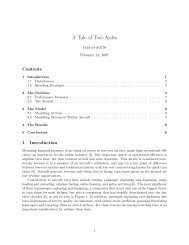Neural Models of Bayesian Belief Propagation Rajesh ... - Washington
Neural Models of Bayesian Belief Propagation Rajesh ... - Washington
Neural Models of Bayesian Belief Propagation Rajesh ... - Washington
You also want an ePaper? Increase the reach of your titles
YUMPU automatically turns print PDFs into web optimized ePapers that Google loves.
11.4 Results 245<br />
deviation σ. Figure 11.4B depicts the feedforward weights for a network <strong>of</strong> 30<br />
neurons, 15 encoding leftward and 15 encoding rightward motion.<br />
θ<br />
t<br />
Rightward<br />
Leftward<br />
F ( θ )<br />
i<br />
Image<br />
5<br />
10<br />
15 15<br />
20<br />
25<br />
30 30<br />
Rightward<br />
P( θ | θ )<br />
iR kR<br />
A<br />
θ t−1<br />
P( θ θ<br />
iL|<br />
jL)<br />
Leftward<br />
5 10 15 20 25 30<br />
To Neuron i<br />
F( θ )<br />
1<br />
0.3 0.3<br />
0.2 0.2<br />
0.1 0.1<br />
5<br />
10<br />
15 15<br />
20<br />
25<br />
30 30<br />
00<br />
0 5 10 15 20 25 30<br />
1 10 20 30<br />
Spatial Location (pixels)<br />
B<br />
From Neuron j<br />
Rightward Leftward<br />
F( θ 15 )<br />
1 15<br />
30 1 15<br />
30<br />
1<br />
1<br />
C D<br />
5 10 15 20 25 30<br />
Figure 11.4 Recurrent Network for Motion Detection (from [30]). (A) depicts a recurrent<br />
network <strong>of</strong> neurons, shown for clarity as two chains selective for leftward and<br />
rightward motion respectively. The feedforward synaptic weights for neuron i (in the<br />
leftward or rightward chain) are determined by F(θi). The recurrent weights reflect<br />
the transition probabilities P (θiR|θkR) and P (θiL|θjL). (B) Feedforward weights F(θi)<br />
for neurons i = 1, . . . , 15 (rightward chain). The feedforward weights for neurons<br />
i = 15, . . . , 30 (leftward chain) are identical. (C) Transition probabilities P (θ t |θ t−1 ).<br />
Probability values are proportional to pixel brightness. (D) Recurrent weights Uij computed<br />
from the transition probabilities in (C) using Equation 11.24.<br />
We model visual motion using an HMM. The transition probabilities<br />
P (θij|θkl) are selected to reflect both the direction <strong>of</strong> motion and speed <strong>of</strong> the<br />
moving stimulus. The transition probabilities for rightward motion from the<br />
state θkR (i.e. P (θiR|θkR)) were set according to a Gaussian centered at location<br />
k + x, where x is a parameter determined by stimulus speed. The transition<br />
probabilities for leftward motion from the state θkL were likewise set to Gaussian<br />
values centered at k − x. The transition probabilities from states near the<br />
two boundaries (i = 1 and i = X) were chosen to be uniformly random values.<br />
Figure 11.4C shows the matrix <strong>of</strong> transition probabilities.
















